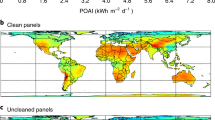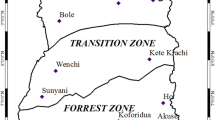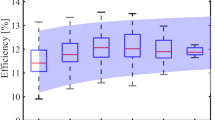Abstract
China is the largest worldwide consumer of solar photovoltaic (PV) electricity, with 130 GW of installed capacity as of 2017. China’s PV capacity is expected to reach at least 400 GW by 2030, to provide 10% of its primary energy. However, anthropogenic aerosol emissions and changes in cloud cover affect solar radiation in China. Here, we use observational radiation data from 119 stations across China to show that the PV potential decreased on average by 11–15% between 1960 and 2015. The relationship between observed surface radiation and emissions of sulfur dioxide and black carbon suggests that strict air pollution control measures, combined with reduced fossil fuel consumption, would allow surface radiation to increase. We find that reverting back to 1960s radiation levels in China could yield a 12–13% increase in electricity generation, equivalent to an additional 14 TWh produced with 2016 PV capacities, and 51–74 TWh with the expected 2030 capacities. The corresponding economic benefits could amount to US$1.9 billion in 2016 and US$4.6–6.7 billion in 2030.
This is a preview of subscription content, access via your institution
Access options
Access Nature and 54 other Nature Portfolio journals
Get Nature+, our best-value online-access subscription
$29.99 / 30 days
cancel any time
Subscribe to this journal
Receive 12 digital issues and online access to articles
$119.00 per year
only $9.92 per issue
Buy this article
- Purchase on Springer Link
- Instant access to full article PDF
Prices may be subject to local taxes which are calculated during checkout




Similar content being viewed by others
Data availability
A subset of the data used in this paper is available from the Chinese Meteorological Administration data portal (https://data.cma.cn). The data that support the plots within this paper and other findings of this study are available from the corresponding author upon reasonable request.
Code availability
The GSEE PV simulation model is available at https://github.com/renewables-ninja/gsee. The code used to produce CFs from the homogenized dataset is available from the corresponding author on reasonable request.
Change history
12 July 2019
In the version of this Article originally published, the units of ‘Total electricity yield’ and ‘Potential electricity gain’ in Table 1 were incorrectly presented as GWh yr–1; they should have been TWh yr–1. These errors have now been corrected.
References
Renewable Energy Statistics 2018 (IRENA, 2018).
Creutzig, F. et al. The underestimated potential of solar energy to mitigate climate change. Nat. Energy 2, 17140 (2017).
Haegel, N. M. et al. Terawatt-scale photovoltaics: trajectories and challenges. Science 356, 141–143 (2017).
National Electric Power Industry Statistics (NEA, 2017).
Renewables 2017: Analysis and Forecasts to 2022—Executive Summary (IEA, 2017).
China Wind, Solar and Bioenergy Roadmap 2050 (CNREC, 2014).
Wild, M. et al. From dimming to brightening: decadal changes in solar radiation at Earth’s surface. Science 308, 847–850 (2005).
Wild, M. Decadal changes in radiative fluxes at land and ocean surfaces and their relevance for global warming. Wiley Interdiscip. Rev. Clim. Change 7, 91–107 (2016).
Streets, D. G., Wu, Y. & Chin, M. Two-decadal aerosol trends as a likely explanation of the global dimming/brightening transition. Geophys. Res. Lett. 33, L15806 (2006).
Wild, M. et al. Global dimming and brightening: an update beyond 2000. J. Geophys. Res. Atmos. 114, D00D13 (2009).
Shi, G. Y. et al. Data quality assessment and the long-term trend of ground solar radiation in China. J. Appl. Meteorol. Climatol. 47, 1006–1016 (2008).
Tang, W. J., Yang, K., Qin, J., Cheng, C. C. K. & He, J. Solar radiation trend across China in recent decades: a revisit with quality-controlled data. Atmos. Chem. Phys. 11, 393–406 (2011).
Yang, S., Wang, X. L. & Wind, M. Homogenization and trend analysis of 1958–2016 in situ surface solar radiation records in China. J. Clim. 31, 4529–4541 (2018).
Qi, Y., Stern, N., Wu, T., Lu, J. & Green, F. China’s post-coal growth. Nat. Geosci. 9, 564–566 (2016).
Li, X., Wagner, F., Peng, W., Yang, J. & Mauzerall, D. L. Reduction of solar photovoltaic resources due to air pollution in China. Proc. Natl Acad. Sci. USA 114, 11867–11872 (2017).
Renewables 2017: Global Status Report (REN21, 2017).
Pfenninger, S. & Staffell, I. Long-term patterns of European PV output using 30 years of validated hourly reanalysis and satellite data. Energy 114, 1251–1265 (2016).
Peterson, T. C., Karl, T. R., Jamason, P. F., Knight, R. & Easterling, D. R. First difference method: maximizing station density for the calculation of long-term global temperature change. J. Geophys. Res. Atmos. 103, 25967–25974 (1998).
Xiao, Q., Ma, Z., Li, S. & Liu, Y. The impact of winter heating on air pollution in China. PLoS ONE 10, e0117311 (2015).
Liu, J. et al. Air pollutant emissions from Chinese households: a major and underappreciated ambient pollution source. Proc. Natl Acad. Sci. USA 113, 7756–7761 (2016).
Blumthaler, M., Ambach, W. & Ellinger, R. Increase in solar UV radiation with altitude. J. Photochem. Photobiol. B 39, 130–134 (1997).
You, Q. et al. Decadal variation of surface solar radiation in the Tibetan Plateau from observations, reanalysis and model simulations. Clim. Dynam. 40, 2073–2086 (2013).
Photovoltaic Power Statistics (NEA, 2016).
Proc. Introducing the 2017 Energy Situation (NEA, 2018); http://www.nea.gov.cn/2018-01/24/c_136921015.htm
Kvalevåg, M. M. & Myhre, G. Human impact on direct and diffuse solar radiation during the industrial era. J. Clim. 20, 4874–4883 (2007).
Bond, T. C. et al. Historical emissions of black and organic carbon aerosol from energy-related combustion, 1850–2000. Global Biogeochem. Cycles 21, GB2018 (2007).
Smith, S. J. et al. Anthropogenic sulfur dioxide emissions: 1850–2005. Atmos. Chem. Phys. 11, 1101–1116 (2011).
Wang, R. et al. Black carbon emissions in China from 1949 to 2050. Environ. Sci. Technol. 46, 7595–7603 (2012).
Folini, D. & Wild, M. The effect of aerosols and sea surface temperature on China’s climate in the late twentieth century from ensembles of global climate simulations. J. Geophys. Res. 120, 2261–2279 (2015).
Liu, B., Xu, M., Henderson, M., Qi, Y. & Li, Y. Taking China’s temperature: daily range, warming trends, and regional variations, 1955–2000. J. Clim. 17, 4453–4462 (2004).
Qian, Y., Kaiser, D. P., Leung, L. R. & Xu, M. More frequent cloud-free sky and less surface solar radiation in China from 1955 to 2000. Geophys. Res. Lett. 33, L01812 (2006).
Norris, J. R. & Wild, M. Trends in aerosol radiative effects over China and Japan inferred from observed cloud cover, solar ‘dimming,’ and solar ‘ brightening’. J. Geophys. Res. Atmos. 114, D00D15 (2009).
Lu, Z., Zhang, Q. & Streets, D. G. Sulfur dioxide and primary carbonaceous aerosol emissions in China and India, 1996–2010. Atmos. Chem. Phys. 11, 9839–9864 (2011).
Wang, R. et al. Trend in global black carbon emissions from 1960 to 2007. Environ. Sci. Technol. 48, 6780–6787 (2014).
Li, C. et al. India is overtaking China as the world’s largest emitter of anthropogenic sulfur dioxide. Sci. Rep. 7, 14304 (2017).
Wu, Y. et al. On-road vehicle emissions and their control in China: a review and outlook. Sci. Total Environ. 574, 332–349 (2017).
Yang, G. et al. Rapid health transition in China, 1990–2010: findings from the Global Burden of Disease Study 2010. Lancet 381, 1987–2015 (2013).
Lelieveld, J., Evans, J. S., Fnais, M., Giannadaki, D. & Pozzer, A. The contribution of outdoor air pollution sources to premature mortality on a global scale. Nature 525, 367–371 (2015).
Huang, R. J. et al. High secondary aerosol contribution to particulate pollution during haze events in China. Nature 514, 218–222 (2015).
Performance Evaluation on the Action Plan of Air Pollution Prevention and Control and Regional Coordination Mechanism (CCICED, 2014).
The Cost of Air Pollution Strengthening the Economic Case for Action (World Bank, 2016).
Lewis, N. S. Research opportunities to advance solar energy utilization. Science 351, aad1920 (2016).
Green, M. A., Emery, K., King, D. L., Hisikawa, Y. & Warta, W. Solar cell efficiency tables (version 27). Prog. Photovolt. 14, 45–51 (2006).
Green, M. A. et al. Solar cell efficiency tables (version 51). Prog. Photovolt. Res. Appl. 26, 3–12 (2018).
Xia, X. A closer looking at dimming and brightening in China during 1961–2005. Ann. Geophys. 28, 1121–1132 (2010).
Müller, J., Folini, D., Wild, M. & Pfenninger, S. CMIP-5 models project photovoltaics are a no-regrets investment in Europe irrespective of climate change. Energy 171, 135–148 (2019).
Ridley, B., Boland, J. & Lauret, P. Modelling of diffuse solar fraction with multiple predictors. Renew. Energy 35, 478–483 (2010).
Acknowledgements
The authors would like to thank J. Müller for the code used to construct the hourly GSEE input data from the daily global horizontal solar radiation data.
Author information
Authors and Affiliations
Contributions
M.W., S.P. and B.S. designed the study. B.S., S.P., M.W. and B.v.d.Z. drafted the article. B.S. and S.Y. gathered the data. B.S. analysed the data. B.S. generated the figures. All authors worked on the final manuscript.
Corresponding author
Ethics declarations
Competing interests
The authors declare no competing interests.
Additional information
Publisher’s note: Springer Nature remains neutral with regard to jurisdictional claims in published maps and institutional affiliations.
Supplementary information
Supplementary Information
Supplementary notes 1–3, Figs. 1–12, Tables 1–2 and references
Rights and permissions
About this article
Cite this article
Sweerts, B., Pfenninger, S., Yang, S. et al. Estimation of losses in solar energy production from air pollution in China since 1960 using surface radiation data. Nat Energy 4, 657–663 (2019). https://doi.org/10.1038/s41560-019-0412-4
Received:
Accepted:
Published:
Issue Date:
DOI: https://doi.org/10.1038/s41560-019-0412-4
This article is cited by
-
A stacking ensemble classifier-based machine learning model for classifying pollution sources on photovoltaic panels
Scientific Reports (2023)
-
Inherent spatiotemporal uncertainty of renewable power in China
Nature Communications (2023)
-
An integrated system with functions of solar desalination, power generation and crop irrigation
Nature Water (2023)
-
Aerosol sensitivity simulations over East Asia in a convection-permitting climate model
Climate Dynamics (2023)
-
Global declarations on electric vehicles, carbon life cycle and Nash equilibrium
Clean Technologies and Environmental Policy (2023)



